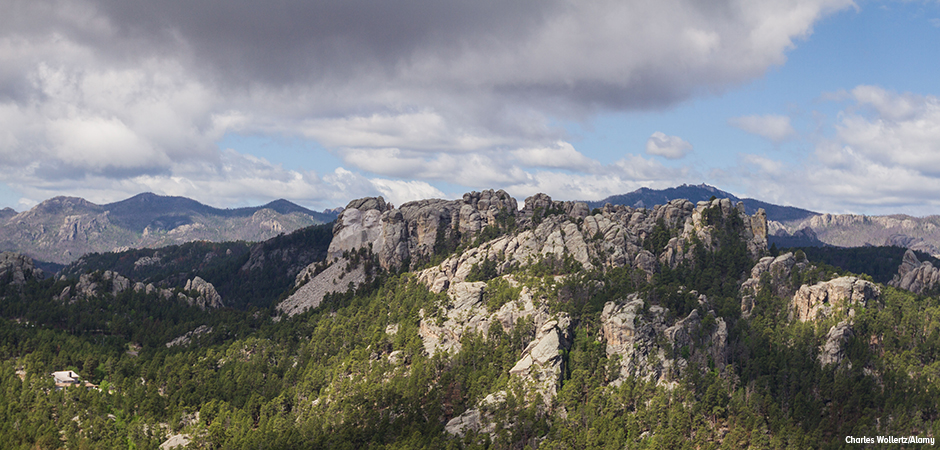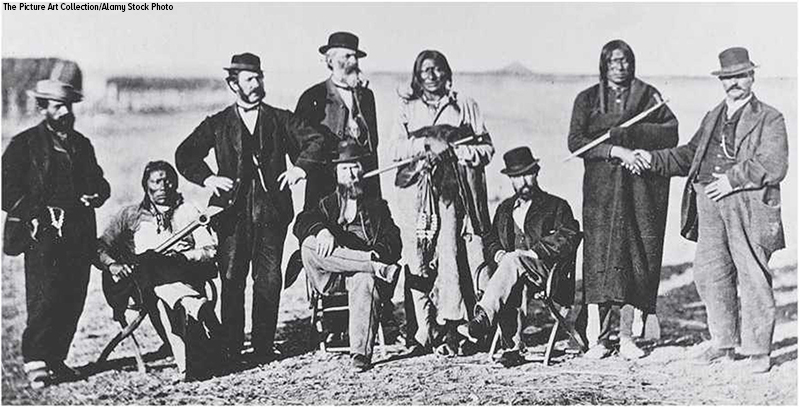
There is a long history of land treaties between the U.S. government and Indigenous Native American people. But did you know that some of these disputes over land are still occurring today? In November 2024, a group of leaders of the Oceti Sakowin considered introducing a bill in the U.S. Congress to return a particularly sacred area to the Oceti Sakowin: the Black Hills of South Dakota. Here, btw takes a closer look at the history of this area, as well as the current legislation being proposed.
Why Are the Black Hills Important?
The Black Hills features a great deal of natural beauty. The area contains Black Elk Peak, the highest point east of the Rocky Mountains. (From the top of Black Elk Peak, visitors can see four states at once: South Dakota, Montana, Wyoming, and Nebraska.) The Black Hills also hold the third largest cave system in the world; gold that is sold locally as jewelry; and a world-renowned mammoth excavation site. It is also the location of the famous Mount Rushmore memorial to four famous American presidents.
But more importantly, the Black Hills are the ancestral home of many Indigenous groups. The Indigenous people of North America believe that He Sapa (the Black Hills) are sacred and the center of the universe. They believe that visiting the Black Hills provides important spiritual and physical renewal.
However, who actually owns the land is still disputed. This is due to the area’s long and difficult history between American settlers and the Indigenous groups that called the Black Hills home.
A Complicated History
In the mid-nineteenth century, violent skirmishes regularly occurred between Indigenous groups and American settlers moving into the region. In 1851, U.S. Superintendent of Indian Affairs Thomas Harvey organized a treaty meeting with the Plains Tribes at Fort Laramie, in what is now Wyoming. The goal was to create a long-lasting peace between the Indigenous peoples and American settlers. Over ten thousand Native American men, women, and children gathered to sign the treaty. So many people came that the meeting was moved thirty miles east to Horse Creek, which is why this treaty is also known as the Horse Creek Treaty.

The Horse Creek Treaty of 1851 gave the U.S. government the right to build roads through Native American lands. The U.S. also agreed to pay the Indigenous groups $50,000 per year for ten years. The Native Americans agreed to stop their attacks resisting the white settlers’ arrival. However, the treaty was never ratified and was broken almost immediately.
In 1868, another treaty attempt was made. This treaty recognized the Black Hills as part of what they then called the Great Sioux Reservation, belonging exclusively to the Sioux people. (The term Sioux was commonly used by early Europeans and Americans at this time but is no longer considered accurate or respectful.) In exchange, the Indigenous people agreed to move to the Black Hills, giving up many thousands of acres of land. They also agreed not to attack settlers or railroads.
But in 1874, gold was discovered in the Black Hills. An expedition of miners, under the protection of U.S. Army soldiers led by General George Custer, moved onto the Native American lands. In 1876, Custer’s soldiers clashed with Lakota and Cheyenne fighters at the Little Bighorn River. Custer and many of his men were badly defeated and many killed. But that didn’t stop the U.S. government from continuing to move against the Indigenous people in this area. In 1877, the U.S. reclaimed ownership of the Black Hills. Ownership of the Black Hills is still disputed today.
A Modern-Day Treaty
In November 2024, members of the Oceti Sakowin Indigenous North American people met in Fort Yates, North Dakota, at the Prairie Knights Casino on the Standing Rock Reservation. The group included tribal, spiritual, and treaty leaders of the Standing Rock Tribe, the Oglala Tribe, the Rosebud Tribe, the Cheyenne River Tribe, a group of Manda Hidatsa Arikara Nation elders, and others. Their goal was to craft a formal declaration demanding that the U.S. return federal land in the Black Hills to the Oceti Sakowin people. Their goal is to introduce this declaration as a bill to Congress in 2025.
The He Sapa Restoration Act is the result of earlier conversations and debates that have been going on about ownership of the Black Hills for quite some time. In the 1980s, the U.S. Supreme Court ordered that $100 million be paid to the Oceti Sakowin, but they refused the money then and still refuse the money to this day. Earlier in 2025, Oceti Sakowin leaders met with representatives from the U.S. Department of Agriculture to draft some agreements which would give Indigenous people the ability to co-manage the land with the U.S. government and build a new visitor center. But Native American leaders say that doesn’t go far enough. They don’t want to co-manage the land. They want it to be fully returned to the Oceti Sakowin.
A Native American representative council has passed a resolution in support of the He Sapa Restoration Act. Under the terms of the proposed legislation, any privately-owned land in the Black Hills would not be affected and would still belong to its current owners. Once federally owned lands are returned, they will be governed in a more traditional Indigenous way, with treaty councils, spiritual leaders, and other traditional cultural leadership roles.
